Our story
- 1875
- 1875 - 1926
- 1892
- 1921
- 1924
- 1925
- 1926
- 1929 - 1933
- 1933 - 1940
- 1945 - 1947
- 1948
- 1950s
- 1956 - 1959
- 1960s
- 1970
- 1970s
- 1980
- 1982
- 1993
- 1997
- 2000
- 2000s
- 2007
- 2014
- 2014 Continued
-
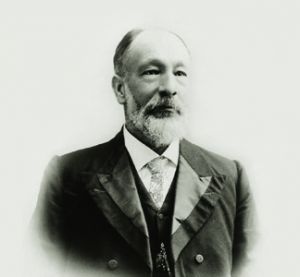
1875
At a time before telephones, before cars and before electric lights, James Lambert Williams started his business at 20 Errol Street, Melbourne at the age of 23, with his young family living upstairs.
-

1875 - 1926
The focus for the business was general plumbing, hot water installations, gas lighting and electric doorbells.
The land boom in the 1880s made many fortunes and was a great time for the business. James L. Williams thrived and by 1885 the expanding business moved to a larger premises at 212 (later 612) Queensberry St North Melbourne. -
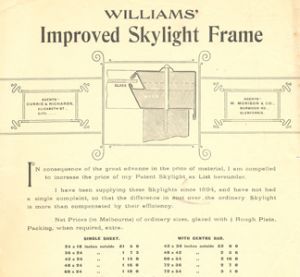
1892
JL patented many of his own inventions including a skylight which he marketed throughout Australian and New Zealand and automatically flushing toilets for public use. Along with a glass washing device to comply with the new regulations of the time that required for glasses to be washed.
-
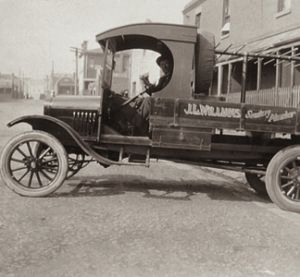
1921
James L. Williams bought their first one-ton T-model Ford truck complete with a customised tray and chassis, a welcomed change from their hand cart and horse and cart combination.
-

1924
James (far left) with his workers in the new brick factory.
-
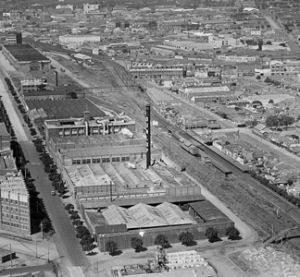
1925
James L. Williams won its largest contract to date, a maintenance agreement with the rubber giant Dunlop at their Port Melbourne works.
Image: courtesy of State Library Victoria -
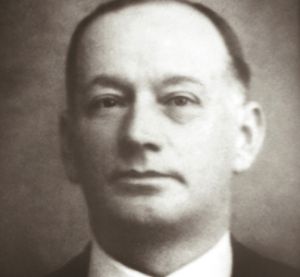
1926
James L. Williams was formed into a limited liability company only three months before James's passing. The business was left to his three sons George, Sidney and John (Jack). George was to later buy out his brothers' shares of the business, paving the way for his own sons Ralph and Alfred to join the business.
Image: George Williams -
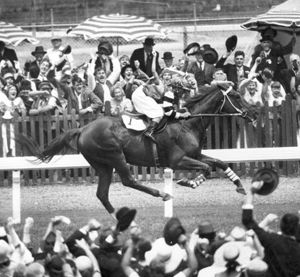
1929 - 1933
The depression, a devastating time for the world and James L. Williams was no exception, losing more than half its capital and all but 10 employees who shared what work was available equally. It was during this time that Phar Lap rose to fame, lifting the spirits of Australians.
Image: Courtesy of National Library of Australia -
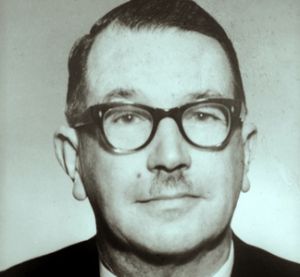
1933 - 1940
Business began to pick up and the company were able to employ more staff, this is until the break out of World War II. Many of the company’s employees were called to war, including Alfred, George's youngest son. With an extreme shortage of work, materials and labour, the next five years were hard. Mentally and physically the skeleton team of workers pulled together to make it through these years of hardship and loss.
Image: Ralph Williams -

1945 - 1947
Alfred returned home at the end of the war and took over running the office only to find that he and his brother Ralph would be swept up in the 20th century's newest and exciting technology...air conditioning.
Like his father, George worked until his death in August 1947. Alf was to find him slumped at his desk one afternoon after suffering a massive stroke. Ralph and Alf carried the business forward together.
Image: Alfred Williams
-
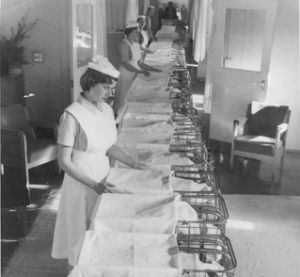
1948
The start of the baby boomer craze and also a monumental time for the business. We won our biggest contract to date, Footscray District Hospital. Designed by W E Bassett and Partners (now AECOM), this hospital was to be Melbourne's first fully air conditioned building and was the beginning of many brilliant hospital projects, including for St. Vincent's Hospital in East Melbourne a couple of years later.
-

1950s
The 1950s saw a number of jobs won in Sydney, partnering with local company G A Winwood & Sons, and in 1955 JLW completed their first air conditioned city building, Norwich Union Insurance, Queen St, Melbourne.
Image: courtesy of Victorian State Library. -
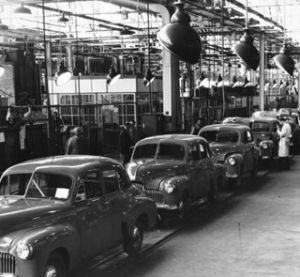
1956 - 1959
The 50s saw the introduction television and rock 'n' roll. These were prosperous times and they were equally good years for James L. Williams. We gained work with General Motors at the Holden plant at Fishermen’s Bend and with the Kodak plant in East Coburg.
Image: New Holden cars roll off the production line in Melbourne. -
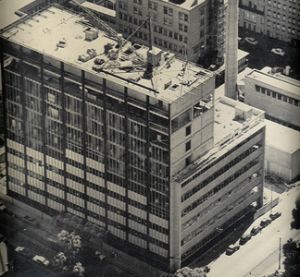
1960s
1960 saw the company venture into the Adelaide market when we begun work on the Adelaide Children's Hospital. The project took six years to complete and was worth more than $3,000,000.
Ralph's son Kent joined the company as the fourth generation of Williams'. -
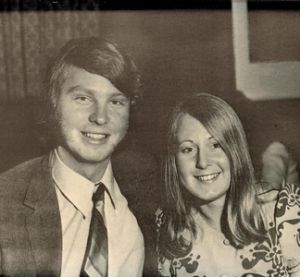
1970
Allen Williams, son of Alfred, joined the company as an apprentice plumber working on many of the projects of the time, including the main ward block of the Alfred Hospital.
Image: Allen and Elizabeth Williams -
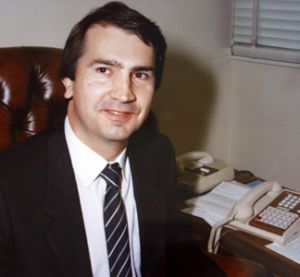
1970s
Were hard times for plumbing and increasingly the work won was heating, ventilation and air conditioning. 1974 saw the establishment of James L. Williams, Wangaratta, a branch that would be sold in 1985 forming O.P. Industries.
Image: Kent Williams -
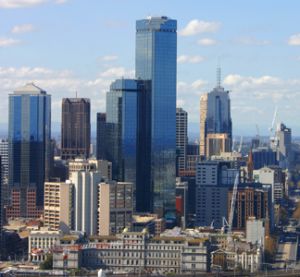
1980
The next 20 years saw JLW complete a string of iconic Melbourne projects; Rialto (pictured), Grand Hyatt, Shell House, 101 Collins St, ANZ World Headquarters and Crown Casino. In NSW business boomed after the Governor Phillip Tower project and subsequently a number of regional hospital projects; Port Macquarie, Maitland and Hawkesbury. Other major Sydney projects included Elarosa (Horizons), 400 George St, No.1 Martin Place (Westin Hotel and GPO redevelopment) and King Street Wharf.
-

1982
An office and workshop was set up in Brisbane, with Len Deverall as the State Manager, considerably growing as business in Queensland expanded. Len was to later be the first non-family member of staff to earn the position of Director (retiring in 1999), his son Gary would later do the same. Further branches in Mt. Isa and then Sydney in 1989 followed not long after.
Image: Len and Gary Deverall -

1993
Kent stood down as Managing Director. Negotiations began for Allen to purchase the shares from Kent's side of the family. Allen Williams became Managing Director and is continuing to take the company forward today.
Image: Allen Williams -
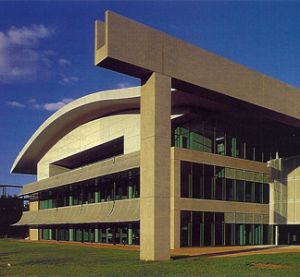
1997
Awarded works on Australian Geological Survey Organisation (AGSO), Canberra – Australia's largest Geothermal air conditioning project.
-
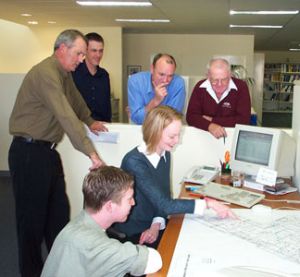
2000
After 34 years, the business moved from 661 Waterdale Rd, West Heidelberg, to 51 Northgate Drive, Thomastown, where its head office remains today.
-
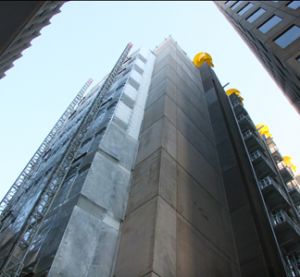
2000s
This decade saw enormous growth in green energy efficient buildings and once again JLW led the way with iconic projects and engineering feats as seen in Australia's first 6-star green rated building Council House 2 (pictured), Melbourne Convention Centre and Pixel Building.
-
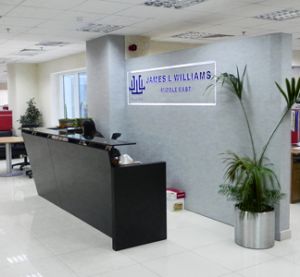
2007
JLW goes international, venturing into the Middle East market with partner Michael Boufahat. Today James L. Williams Middle East is a thriving business unit with approximately 2000 staff under management.
-
2014
A mighty tough decision was made to close the doors of James L Williams and James L Williams (Q) in March 2014. After battling through some tough projects and a tough economic climate, the continuation of the Business was an unviable option. The Family would like to express their deep gratitude for those countless employees, suppliers, sub-contractors and friends to JLW whom have shared their support and blessings to us during this difficult time. We wish each and every one of them a wonderfully bright future.
-
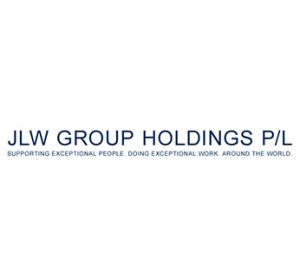
2014 Continued
The Williams Family shifts its focus onto the brilliant potential of GJ Walker, JLW Middle East, Pitts Walker Engineering and Cold Magic Australia through JLW Group Holdings Pty Ltd.
Supporting exceptional people. Doing exceptional work. Around the world. -
